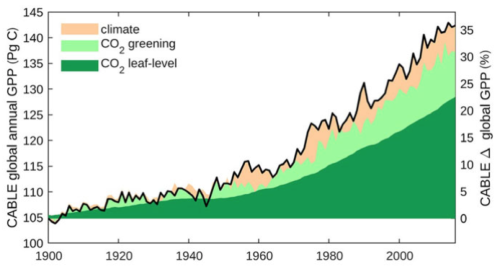All together now, CO2 is plant food. We need to remind ourselves of that basic scientific truth in an era in which this essential molecule has foolishly been relabeled “carbon pollution.” Despite the nonstop alarmism about the supposedly devastating effects of CO2 on the environment, nature continues quietly but firmly to dissent. The latest evidence, following last week’s item about bigger tastier veggies, comes in a new peer-reviewed journal article, summarized by Patrick Michaels at Judith Curry’s Climate Etc. blog, showing that the rise in atmospheric CO2 has yielded a 30% worldwide increase in plant growth rates (Gross Primary Production) since 1900, nearly double the previous estimate. Which you can file under “the science is settled”. But using the new evidence of higher CO2 fertilization, the authors estimate that the extra biomass will, over the current century, effectively counteract 17 years of human CO2 emissions, which as Michaels points out, is enough to satisfy the Paris Accord.
It’s a remarkable irony that among all the people and organizations that call themselves “green”, namely green politicians, green businesses, green activists etc., the one thing they all seem to agree on is that CO2 is the enemy. Yet CO2 is doing more to green the planet, literally, than experts imagined possible 30 years ago. Another irony is that green activists and politicians have done precisely nothing over the past 30 years to reduce global CO2 emissions (despite all the money they have wasted trying), yet CO2 itself is doing the job by stimulating greening of the Earth’s biosphere, which in turn is pulling enough CO2 out of the air to offset 17 years’ worth of CO2 emissions.
Setting aside any climate-emergency considerations for a moment, just imagine how much more starvation and misery there would be if the planet were as brown as it was in 1900. Or if we shoved it back in that direction because we didn’t know what pollution meant.
One of the diagrams in the new study reveals just how much CO2-induced greening has done over the past century:

The two green lines show the expansion of green biomass by direct leaf-level enlargement (dark green), expansion of green areal extent (light green) and the indirect benefits of climate warming (brown). Notice also the lines are accelerating. While alarmists can always cherry-pick a single plant in a single location that experiences stress due to warming or extra CO2, the overall picture is massively positive. Combined with evidence that total emissions won’t be nearly as high as alarmist forecasts (see next item in this newsletter) the clear conclusion is that we are on track for the minimum overall climate-change path out of the range we have been warned about, and it will leave us on a much greener planet than the one we inherited.
So yes, we can all eat more greens. As long as the greens don’t get their way.



Carbon dioxide as carbon pollution? The distinction is simple: Carbon dioxide is what an environmentalist exhales, while what you exhale is carbon pollution! 😉